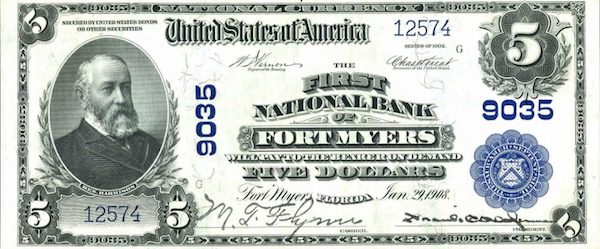(This item originally appeared at Forbes.com on November 24, 2016.)
http://www.forbes.com/sites/nathanlewis/2016/11/24/the-best-monetary-move-trump-could-make-in-his-first-100-days/#13b8f7972257
The best legislative action, regarding monetary affairs, that the new Trump administration could take in its first 100 days in office would be: to eliminate all taxes and restrictions on transactions in gold and silver, which would allow them to be used freely as an alternative form of money.
This would allow people to use services like Bitgold, commercial bank checking accounts denominated in gold, or even privately-issued banknotes without impediment, alongside the floating fiat dollar. They could use gold coins too if they wanted to.

A 1902 gold-based banknote issued by the First National Bank of Fort Meyers, one of thousands of note-issuing banks of the time.
This was the idea behind Ron Paul’s Competition in Currency Act of 2011, H.R. 1098. It has already been implemented on the state level: in 2011, Utah eliminated all state-level taxes on gold and silver, with the intent of allowing them to function again as legal money, as described in the U.S. Constitution Article 1 Section 10. Texas and Louisiana also eliminated state-level taxes in 2013. Another dozen or so states were reportedly considering similar moves. Nevertheless, the States are still subject to Federal-level taxes and restrictions, which limits the practical usefulness of these steps.
People could vote with their feet; free to make contracts or engage in transactions with either gold and gold-based vehicles, or Federal Reserve Notes. Probably, nothing much would change at first. But, over time, people might find they like gold better.
In 1912 – just before the introduction of the Federal Reserve in 1913 – there were 7,307 private banks in the U.S. issuing banknotes, within the framework of the National Bank System. All of them were linked to gold at the official parity of $20.67/ounce. The U.S. Treasury itself issued gold and silver certificates. The U.S. had already rejected the model of the monopoly central bank, exemplified by the Bank of England, three times. The first was before the United States was even formed: the Bank of North America, in effect a “central bank,” was chartered by the Congress of the Confederation in 1781. It was later quashed.
The First Bank of the United States was founded in 1791, and was dechartered in 1811. The opponents to currency monopoly – including Thomas Jefferson – thought the idea had been killed. But the War of 1812 with Britain broke out soon afterwards, and in 1816, the U.S. had another central bank, the Second Bank of the United States. President Andrew Jackson killed it in 1836, and also managed to pay off the entirety of the Federal debt.
It is perhaps not quite the time for such drama today. But, it would be an easy matter to simply allow people to use gold, and gold-based alternatives, as money again, without restrictions or impediments. There’s no downside, and plenty of potential upside – unless you are a privately-owned fiat currency monopolist, of course.

